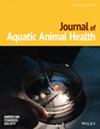The hellbender Cryptobranchus alleganiensis is a fully aquatic, long-lived, and state endangered salamander endemic to the eastern and central United States. Chytridiomycosis is a fungal skin disease of salamanders that can be caused by either Batrachochytrium dendrobatidis (Bd) or by recently described B. salamandrivorans. B. salamandrivorans is responsible for massive mortality of salamanders in Europe but, to date, has not been reported in the United States, in contrast to Bd. Common signs of Bd infection in salamanders are excessive skin shedding; cutaneous discoloration; mainly in ventral parts of the abdomen and thighs; and eventually death as a result of osmotic imbalance.
Eastern hellbenders C. a. alleganiensis in the Aquaculture Research Laboratory at Purdue University experienced 33% mortality. Three of the deceased animals were autopsied, and samples for histopathology, microbiology, and Taqman quantitative polymerase chain reaction were taken.
Autopsy revealed an abundant, thick, yellow to green mucoid material on the surface of the skin, mainly on the tail and flanks. Histopathology of the skin samples revealed infection with chytrid fungus consistent with chytridiomycosis. Taqman quantitative polymerase chain reaction confirmed presence of Bd, and bacterial culture confirmed co-infection with Aeromonas hydrophila. Infected hellbenders were treated with ciprofloxacin, itraconazole, and ceftazidime.
The chytridiomycosis outbreak was most likely caused by sudden environmental stress due to filtration failure and secondary bacterial infection. The surviving animals have not shown any clinical signs of chytridiomycosis for more than 1 year after the treatment and were released the wild river system.



